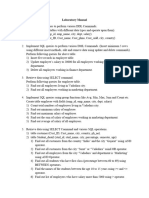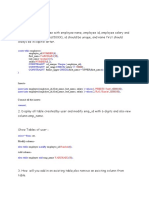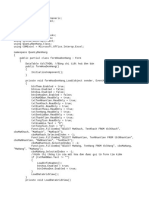0% found this document useful (0 votes)
8 views18 pagesRDBMS
The document contains a series of SQL programs that create and manipulate various database tables, including customer, sales, hospital, employee, and product tables. It demonstrates the use of SQL queries for data insertion, selection, updating, and deletion, as well as implementing constraints, joins, and aggregate functions. Additionally, it includes functions for calculating electricity bills, Fibonacci numbers, and grading based on average scores.
Uploaded by
Fouzan Muhammed KVCopyright
© © All Rights Reserved
We take content rights seriously. If you suspect this is your content, claim it here.
Available Formats
Download as PDF, TXT or read online on Scribd
0% found this document useful (0 votes)
8 views18 pagesRDBMS
The document contains a series of SQL programs that create and manipulate various database tables, including customer, sales, hospital, employee, and product tables. It demonstrates the use of SQL queries for data insertion, selection, updating, and deletion, as well as implementing constraints, joins, and aggregate functions. Additionally, it includes functions for calculating electricity bills, Fibonacci numbers, and grading based on average scores.
Uploaded by
Fouzan Muhammed KVCopyright
© © All Rights Reserved
We take content rights seriously. If you suspect this is your content, claim it here.
Available Formats
Download as PDF, TXT or read online on Scribd
/ 18
























































































